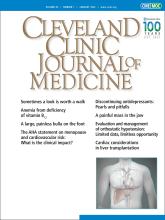A 71-year-old woman with a history of diabetic neuropathy presented with a large, painless bulla on her right foot. She said it had started as a small vesicle but had slowly enlarged over the past 3 days. She had been working in her yard for several days prior to the development of the vesicle but did not sustain any insect bites or local trauma. She reported no fever or chills, and she had no history of skin vesicles or bullae or similar lesions on other parts of her body. No new medications had been recently prescribed.
Her medications at the time of presentation included metformin extended-release 500 mg once daily, insulin lispro protamine–insulin lispro (75/25) 35 units twice daily, anastrozole 1 mg daily, and gabapentin 600 mg twice daily. She was not employed, mostly stayed at home, and had no history of smoking or alcohol or drug use. Comorbidities included breast cancer treated with chemotherapy and radiotherapy 1 year previously, type 2 diabetes mellitus with peripheral neuropathy, and hyper lipidemia.
On physical examination, the patient’s vital signs were normal, and examination of the extremities revealed a large, tense, noninflammatory bulla at the base of the first metatarsal joint of the right foot, 3.75 cm in diameter and containing clear fluid (Figure 1). There were no other lesions on the extremities or trunk and no signs of local inflammation or spontaneous drainage. She had decreased perception to monofilament on both feet with normal peripheral pulses. As the bulla contained clear fluid, it was presumed to be sterile and thus, to avoid the risk of secondary infection, aspiration was not attempted. At a 4-week follow-up visit, the lesion had completely resolved, and the patient did not report any recurrence (Figure 2).
A large, tense, noninflammatory bulla 3.75 cm in diameter at the base of the first metatarsal joint of the right foot. The bulla contained clear fluid.
At a 4-week follow-up visit, the lesion had completely resolved with no signs of recurrence.
Laboratory testing during the follow-up visit revealed a hemoglobin A1c of 10.3% (reference range < 5.7%), serum creatinine 0.87 mg/dL (reference range 0.60–0.93 mg/dL), and albumin-to-creatinine ratio 12 μg/mg creatinine (reference range < 30 μg/creatinine). Results of other laboratory testing were normal, including complete blood cell count, alanine transaminase, aspartate transaminase, total protein, and albumin.
BULLOUS DISEASE OF DIABETES
Bullosis diabeticorum is a noninflammatory blistering condition that affects patients with prediabetes and diabetes.1 The condition was first reported by Kramer in 1930, and the name was coined by Cantwell and Martz in 1967.2 The blisters are tense with serous content. They are recurrent and spontaneous around acral regions, particularly on the lower extremities, including the toes and plantar area of the feet. They can also be present on the hands and forearms. They seldom present on the trunk.3–7 Vesicles and bullae can range in size from 0.5 cm to several centimeters. It is a rare disease, affecting approximately 0.5% of diabetic patients. Men are twice as likely as women to develop the condition.
Because bullosis diabeticorum mostly affects patients with diabetes mellitus who have associated nephropathy and neuropathy, it has been postulated that microangiopathy and disturbances in carbohydrate metabolism may lead to premature aging of connective tissue and other structural alterations in connective tissue,8 increasing the risk of spontaneous appearance of these lesions.2 The lesions are usually self-limited and heal within 4 to 6 weeks without scarring.5
Treatment is conservative, and the blister should be kept clean and protected to avoid secondary infection. No antibiotic therapy is required, although fluid aspiration and culture with use of oral antibiotics may be considered if secondary bacterial infection is suspected.6 Signs of possible infection include erythema, warmth, edema with surrounding inflammation, the presence of purulent fluid or drainage, and fever. The etiology is unclear.
The differential diagnosis for bullosis diabeticorum includes insect bite reaction, contact dermatitis with bullae, poison ivy dermatitis, bullous drug eruption, bullous impetigo, edema bullae, burns, and friction blister.7 Unlike friction blisters, bullosis diabeticorum often develops overnight and in the absence of known trauma.2 Friction blisters are generally associated with high levels of exercise and activity and are often seen in active military personnel or athletes with no underlying health issues, whereas bullosis diabeticorum commonly presents in the absence of foot trauma or pressure in vulnerable populations. Although rare, recurrent episodes leading to severe infection and ulceration have been described, with some bullae recurring years after the initial appearance.9
TAKE-HOME POINTS
Bullosis diabeticorum may be the first clinical presentation of hyperglycemia.2 Bullosis diabeticorum in patients with diabetes often signals poor diabetes control or the existence of associated neuropathy or nephropathy. Patients with this condition should be routinely screened for diabetes and for microscopic proteinuria and assessed for findings of peripheral neuropathy. Supportive care of the lesions with monitoring for signs of secondary infection is advised.
DISCLOSURES
The authors report no relevant financial relationships which, in the context of their contributions, could be perceived as a potential conflict of interest.
- Copyright © 2022 The Cleveland Clinic Foundation. All Rights Reserved.








